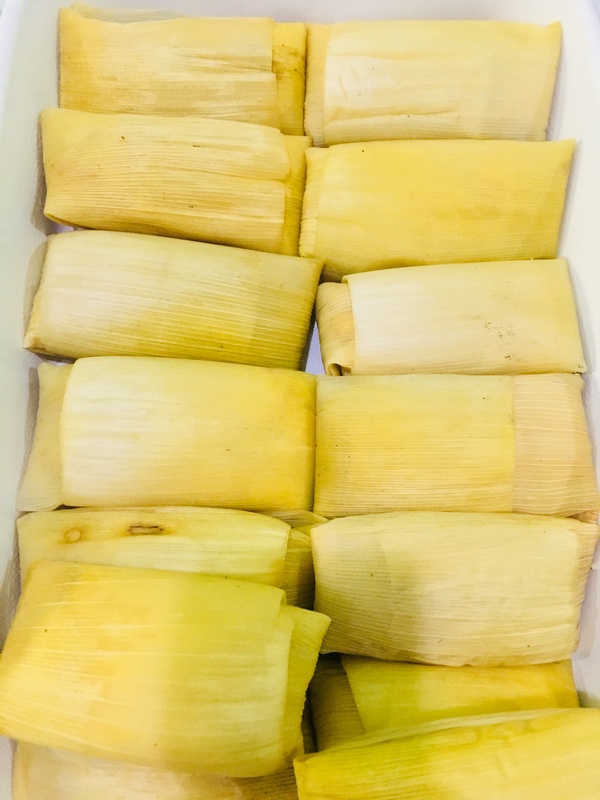
My foie gras mousse-stuffed pintos (rolled in corn husk) served with this suite of petit fours: kabog yema lollipop, tablea-coated ampaw, green mango with salmon roe, salted caramel bukayo and a shot glass of nouveau cappuccino.
IN THE science of food pairings, I learned that cooking ingredients work well together when they share certain flavor profiles, or flavor compounds, and in most cases, aroma profiles, which happen, food scientists hypothesize, at the molecular level.
It is no wonder fusion cooking, especially in the West, came about when certain ingredients, and cooking methods from different geographical regions of the world come together in a dish, creating a whole new culinary and cultural experience altogether.
But fusion cooking must happen organically, Chef Edward Lee underlines.
Fusion should not be a conscious, or worse contrived, effort to cook a fusion dish because you want a Thai-Argentinian dish.
Fusion should “happen immersed through cultures.” And I would add, flavors coming together beautifully, harmoniously.
It is that time when there’s a part we embrace tradition, and then that part when we break away from it, for food to evolve.
As everything must.
In an episode of “The Mind of A Chef,” Filipino-American chef Paul Qui demonstrated preparations for his red snapper kinilaw.
While he had all the traditional ingredients in his acidic marinade (coconut milk, vinegar, shallots, chives, and calamansi), Chef Paul introduced into the preparation of this dish some Japanese fish-cutting technique (to get the right texture of the fish) and a process called yubiki, to blanch the fish’s skin in hot water should one decide to eat raw fish with the skin on.
I can say a lot of these culinary moments happen in my kitchen, especially when I create my dishes.

Bogo’s famous delicacy, pintos
Being new to cooking, and having no, formal or informal, training in a professional Filipino kitchen, I always feel like I am not bound by any set of methods or techniques, or say, cooking traditions, when I do my own versions of local dishes.
My only guide is the standard I impose on my work, some intuition, and imagination of how I want my dish to be.
A few months ago, during a gastronomic trip organized by the provincial tourism office, to the northern towns on the island, I had my first taste of pintos, Bogo’s famous corn delicacy, at Arapal Nature Retreat in Bogo City.
My first pintos, after a long time. Stuffed with pork, it was served as a savory dessert, which I thought could have been a whole lunch meal in itself.
I have always wanted to include pintos in my ever-changing tasting menu, as part of a suite of petit fours to be served after the main dessert. I have no idea how pintos are done, except for the recipe I found in Louella Alix’s book, “Hikay, the Culinary Heritage of Cebu.”
The procedure is very straightforward and simple, and consists of only five steps using three ingredients: grated young corn, grated coconut and sugar (although, others use sweetened condensed milk).
So, when I went back to my kitchen, I envisioned a more refined pintos, with a finer and softer texture, better mouthfeel.
And I wanted it with savory filling like the one I had in Arapal. Something like a surprise in the middle of it.
Then I remembered how foie gras was made using the age-old technique called gavage, to force-feed ducks or geese with corn to fatten the liver.
Corn and foie gras were, I thought, interminably linked, although I realized there really was no corn in foie gras. But foie gras in corn-based pintos somehow made sense to me.
Here’s what I did. First I had to process my corn. Instead of grating the young corn kernels (because I wanted a finer texture and melt-in-your-mouth consistency), I blanched my corn in boiling water until soft before liquidizing them using a high-wattage hand blender.
I passed the purée through a fine sieve, and mixed in some cornstarch, masa harina, condensed milk, egg yolks and melted butter, and blended them together until dough-y enough for the mixture to hold shape on my palm, easier to fill in the foie gras stuffing.
I wanted my foie gras in the same consistency and texture as the pintos, thus it had to be in the form of a mousse. My foie gras was cooked sous vide at 58C for 15 minutes before creating the mousse with béchamel sauce, softened butter and seasoning.
Although, all the main components were already cooked, I steamed my cornhusk-wrapped, foie gras mousse-stuffed pintos for about 15-20 minutes before serving.
With the pintos I had in mind, I had to muster and adopt some western techniques (well, some modern) and flavors in the whole process to achieve the outcome I envisioned for the dish.
To me, it’s not about bastardizing the local delicacy, nor being unfaithful to traditions; it has more to do with acknowledging cuisine to be dynamic and constantly evolving, the same way art and culture are, in general.
Sometimes, it’s just as basic as knowing and doing what feels, or tastes, right.
